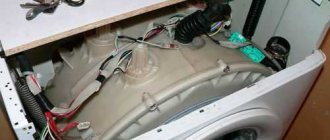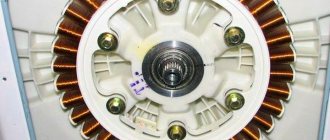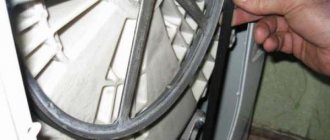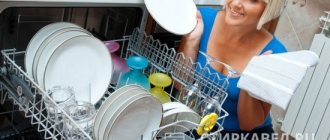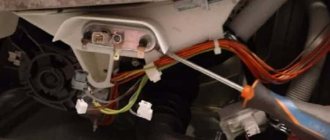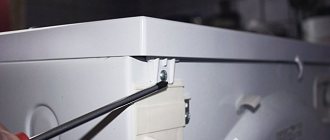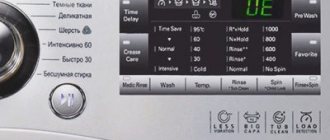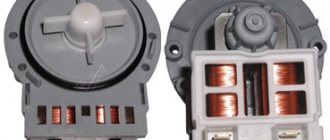Household appliances stores offer customers a wide selection of washing machines, differing in color, price, size, set of functions, energy consumption and a huge number of other parameters. Among them are the features of such important components as the tank and drum of the washing machine. It is these details that determine the capacity of the model, its service life, efficiency, sound volume during operation, as well as the most important indicator: the quality and thriftiness of washing.
To make the best choice, you should have an idea of what manufacturers offer and what the features of each offer are. In this article, we will provide complete and detailed information about washing machine tubs and drums, leaving readers to decide what suits them best.
Tank and drum: what's the difference
Many users confuse the concepts of “tank” and “drum”, or rather, they use both words to refer to the container into which laundry is loaded.
In fact, we load the laundry into a drum located inside a container - a tank into which water is poured with detergent dissolved in it.
Water enters the drum from the tank through a large number of small holes - perforations. The drum rotates, but the tank remains motionless.
What are they?
There are only two types of washing machines with air bubble washing: automatic and activator.
Automatic
This is a classic, familiar machine with a round door. Before washing, clothes are placed in the drum, and powder or any other detergent for clothes is poured into a special hole. When the washing process starts, the water washes out the powder and flows with it into the drum, and from there into the bubble generator. There it interacts with the air and rises again, this time in combination with bubbles and powder.
The resulting bubbles begin to come into contact with the fabric, penetrating its fibers and destroying dirt, stains and odors. When they burst, they produce heat, so many experts compare this effect with boiling and boiling laundry. It’s just that after classic boiling the fabric can become unusable, but after bubble boiling it never will.
How does a washing machine tank work?
The tank of washing machines is a reservoir, which is sometimes solid (non-separable), and sometimes consists of two halves, fastened with bolts or a clamp.
The second option is more preferable because it allows you to carry out repair work without much difficulty. It is almost impossible to repair a solid cast tank, and if any bearing breaks, it must be replaced along with the drum.
It is difficult to come up with anything unusual in the design of the tank. However, some developers have succeeded. So in LG and Hansa cars the tank (and therefore the drum) is not located parallel to the floor, but at an angle. This, firstly, makes loading and unloading laundry more convenient, and, secondly, improves the quality of washing, since the laundry in the inclined tank, when the drum rotates, falls into the water not on the same side, but on different sides, as a result of which more cleaning is done. evenly.
But in the Candy washing technology, the tank is not round, but oval, or rather egg-shaped. This reduces its internal volume, allowing you to reduce the amount of water required for washing, and therefore the electricity required to heat it, and the detergent.
List of manufacturers of SMA with a collapsible tank
Most models released 50-10 years ago had collapsible tanks. Today, preference is given to the non-separable option - almost all brands are gradually switching to one-piece structures. Finding SMAs with collapsible tanks is becoming increasingly difficult.
Review of brands producing SMA with RB:
- ATLANT (“Atlas”). A Belarusian brand that produces narrow and full-size washing machines in a low price range - from 12,500 to 25,000 rubles. Their inexpensive but high-quality models are designed for the common consumer who is not used to throwing cars away: if something breaks, it can be fixed.
- . A well-known Korean brand that produces frontal washing machines in a wide price range - from 18,000 to 275,000 rubles. LG is one of the brands that represents the best SMAs on the market, economical, functional, and full of modern technologies. True, there is a hitch with replacing the bearings. Even though the tank can be unscrewed onto the forecastles, it is not possible to change the bearings. A cheap replacement of the rear forecastle helps compensate for the disappointment - it is produced by certified centers.
- A.E.G. A German brand that produces SMA at least middle class. Price range: 32,000–100,000 rubles. The range includes vertical and front modifications, including built-in ones.
- Samsung. Korean is famous for innovation. Many of its models are controlled from a smartphone. On the Russian market it presents models ranging from 16,000 to 80,000 rubles.
- Electrolux. This Swedish brand represents devices of all types - Electrolux has frontal and vertical, narrow and full-size, built-in and free-standing SMAs. The lower price threshold is 20,000 rubles, the upper one is 140,000 rubles.
- Gorenje. A Slovenian company that, in addition to conventional vertical and front-facing machines, also has washing machines with an additional tank - they can work without being connected to a water supply. Cost - from 16,000 to 30,000 rubles.
- Siemens. Among the products of this German brand there are frontal devices for 20,000 and 120,000 rubles. The assortment includes many modifications of narrow and full-size versions. Built-in models are also available.
- Haier. A large Chinese manufacturer that produces devices in all price segments - from 20,000 to 120,000. Haier offers side-loading SMAs. An unusual modification - with two reels.
Which manufacturers do not disassemble the tank, list of brands:
- Indesit (“Indesit”). Italy.
- Ariston (“Ariston”). Italy.
- Beko (“Beko”). Türkiye.
- Candy (“Candy”). Italy.
- Zanussi (“Zanussi”). Italy.
- Whirlpool (“Whirlpool”). USA.
- ARDO (“Ardo”). Italy.
Both options are found in Bosch brand washing machines. SMA series WAA have a non-separable version, WAE - a collapsible version. The Bosch WLG washing machine is available in two types of models. When buying a Bosch, you should be especially careful if the issue of internal structure is important to the buyer.
What are tanks made of?
In addition to the design, washing machine tanks differ in material. For some reason, it is generally accepted that stainless steel tanks are the best: they are supposedly the most durable. Indeed, such a tank can last 50 - 70 years. But what to do with it when the washing machine breaks down? In addition, the steel tank makes the entire structure heavier, increases vibration and resonates with the drum, making the machine noisier.
Another option is a tank made of enameled metal. It has all the same disadvantages as stainless steel containers.
In most cars, the tanks are made of either durable plastic or modern composite polymers. And, I must say, this is completely justified, because even plastic tanks break infrequently, and even more so composite ones. Breakdowns are usually caused by hard objects accidentally falling into the drum along with the laundry. The tank can be pierced by bra wires and other similar things.
The advantages of polymer tanks include corrosion resistance, quiet operation, and good thermal insulation, which helps save energy when heating water.
Many companies make the tanks of their cars from proprietary polymer materials. So, in Electrolux machines it is called carboran, in Candy - silitech, in VEKO - carferron, in Bosch-Siemens - polynox, in Whirlpool - fibran, in Gorenje - polytenax and carbotech.
ARDO took an original approach to the design of the tank. This part combines plastic, from which the side walls are made, and stainless steel, which is the basis for the rear wall. This design, called “polycarbonat + inox,” retains all the advantages of a plastic tank and gives special strength to the unit that connects the tank to the drum shaft.
Types of material
Now let’s look at which tank (from which material) in the washing machine is better. As already mentioned, different materials are used to make the tank (stainless steel, plastic, metal). Let's consider all the advantages and disadvantages of these materials for an important part of the washing device.
Stainless steel
Tanks have been made from this type of material for a long time.
Stainless steel has proven itself well due to its ability to withstand contact with water. Pros:
- it is not subject to corrosion;
- quite durable;
- has a long service life;
- resistant to chemical elements;
- tolerates the effects of anti-scale medications well.
Minuses:
- Stainless steel tanks are very noisy because metal cannot dampen vibration;
- this is a fairly heavy metal that affects the weight of the tank and the machine as a whole;
- Stainless steel does not have thermal insulation properties, which is why the energy consumption will be slightly higher;
- models of machines with tanks made of high-quality stainless steel are quite expensive.
Plastic
First, you need to understand that plastic refers to various composite polymer materials.
Some manufacturers make their own materials themselves, giving them their own brand names. Moreover, the characteristics of different types of plastic are different from each other. If we consider, for example, “carboran”, it will be more durable, and in terms of strength and reliability it will not be inferior to stainless steel. In addition, it has the ability to dampen vibration, which stainless steel does not have.
Main composite, polymer materials:
- Polyplex;
- Polynox;
- Silitek;
- Carborane;
- Karbotek;
- Carferron.
Pros:
- they are relatively durable;
- do not corrode;
- do not allow liquid to pass through;
- they are light in weight;
- have the ability to reduce drum noise during spinning;
- save energy;
- are not exposed to chemicals and aggressive substances.
Minuses:
- There is actually only one minus here, but it’s quite big. Any polymer materials are brittle by nature and prone to splitting. Any poor quality or improper transportation of the device, or failure to remove the transportation bolts in time before using the washing machine, may damage the integrity of the tank. After which he will be unfit for work. You will need to replace the tank or even buy a new car.
Metal
Pros:
- Tanks made of metal coated with an enamel layer are quite reliable and not subject to corrosion. They are quite strong and do not crack during transportation or large temperature changes.
Minuses:
- heavy weight;
- they are susceptible to impacts and chips.
Attention. If during operation chips or damage to the protective layer of enamel appears, the metal begins to quickly rust and collapse. The tank is leaking, you will have to buy a new washing machine, since such tanks have no longer been produced.
Washing machine drum: general information
The washing machine drum is a cylinder inside the tank. While tanks can be made from several materials, only sheet stainless steel is used for the drum.
One side of the drum has a hole through which laundry is loaded into it. A cross with a shaft is attached to the reverse side, which transmits rotation to the drum from the motor.
Inside the drum there are linings or ribs called strikers. They help stir the laundry during the washing process. The strikers can be straight or have various curved shapes. The latter is more preferable, since such shapes help to mix the laundry more evenly and redirect it to the center of the drum.
Often the loopholes are made hollow inside. Lowering as the drum rotates downwards, the striker collects soap solution, and when it rises, water pours out of it, providing the laundry with a shower effect.
Main unit of the machine
The drum is the key element of the washing machine, and almost all parts of the machine interact with it. The stainless steel cylinder is the user-visible part of the unit through which laundry is loaded into the machine. For front-loading washing machines, the “input” is located in the front, and for “vertical” washing machines, it is on the top. Dirt is washed off due to the special design of the container: water gets inside through perforations on the walls, and a rubber cuff with a hatch door provides the necessary tightness.
The remaining elements of the node are “hidden” from the user’s eyes. The first of them is the tank in which the drum is located. This is a large, lightweight and durable container, to which the powder receiver hose is attached to the top, and the drain pipe is connected to the bottom. The cylinder is connected to the tank from the back using an iron cross, bushing and bearings.
The drum is built into the tank, where it is held by a cross, and is spun thanks to an axis, drive and motor.
The rotation of the system is provided by a shaft that receives impulses from the engine. The latter is located under the washing tub and can be collector or inverter. The motor reaches the specified speed, which is transmitted to the cylinder through a direct drive or a pulley with a belt. The acceleration speed is controlled by a Hall sensor.
The vibration emanating from the motor is damped thanks to the provided shock absorption. The tank and drum are held in a suspended position, which is ensured by springs and vibration dampers. The containers are fixed securely, but not rigidly: the mobility and elasticity of the unit is maintained. The centrifugal force is also compensated by counterweights - concrete blocks, which weigh down the machine by tens of kilograms.
Next to the drum cylinder, in the back of the tank there is a hole for a tubular electric heater - heating element, which is responsible for heating the water to the desired temperature. The heat comes from the coil located directly in the washing tank, and the contacts are brought out and protected by a sealed gasket. The degree of heating is monitored by a temperature sensor that transmits data to the control module.
In some machines, the location of the main components may vary - it all depends on the manufacturer and model. To find out more precisely how a particular washing machine works, just look at the factory instructions.
Washing machine drum: perforated
The side surfaces of the drum, and sometimes its back wall, are covered with many small holes - perforations. Their sizes and locations may differ significantly from one manufacturer to another. The holes are necessary to allow the cleaning solution to enter the drum. At the same time, their presence contributes to faster wear of linen.
As the drum rotates, the items in it are subject to a centrifugal force, which presses the laundry against the walls and “presses” the fabric into the perforation holes. As a result, the fibers fray and the fabric deteriorates over time. It is not for nothing that hand washing is considered more gentle than machine washing. Fiber wear can be particularly severe when spinning at high speeds.
What is a bubble drum?
This is an improved model of the device described above. In addition to the holes, the drum has hemispherical elements of different sizes extruded into the metal walls. ... At the same time, bubble drums increase the impact of centrifugal force, which is why the laundry also releases moisture better.
Interesting materials:
How to use asparkam correctly? How to take arginine tablets correctly? How to take BCAA powder correctly? How to take Fish Oil correctly? How to take collagen capsules correctly? How to take creatine before or after meals? How to take l carnitine tablets correctly? How to take flaxseeds correctly? How to take methane tablets correctly? How to take Omnadren correctly?
Washing machine drum: innovations for gentle washing
Manufacturers of washing machines are trying to improve the situation with the help of various washing modes, special algorithms for rotating the drum and searching for such machine operating parameters that, on the one hand, will ensure proper washing quality, and on the other hand, will minimize fabric wear. One way to achieve this is to make washing machine drums with a special inner surface.
Honeycomb drums
Modern designers very often look for clues to solve problems in nature. This is exactly what the Miele developers did when they paid attention to honeycombs. Regular structures made of wax hexagons, despite the fact that they are made of a soft material, turned out to be quite stable, which gave rise to the idea of using similar shapes in washing machines.
The inside of the Miele washing machine drum is covered with stamped convex hexagons. The perforation of the drum also has its own characteristics: its holes have a smaller diameter than usual, and their number is also reduced. This allows the washing solution to linger in the drum longer, escape from the drum and damage machine parts, which improves the quality of washing, and the small size of the holes prevents foreign solid objects from being forgotten in pockets. But the main advantage of the honeycomb drum is that the fabric is practically not pulled into such small holes, which means it is washed more carefully. The bulges of the hexagons also help keep textile fibers away from destructive holes.
The idea of Miele engineers has found application in washing machines of other brands. Thus, the company has created a high-tech Diamond Drum, in which the perforations are located in pyramid-shaped recesses.
The perforation diameter reduced by 25 percent prevents fabric from penetrating through the holes, protecting it from damage and wear. The shape of the “pyramids” really resembles faceted precious stones, so the name of the drum is not only an effective advertising ploy.
Drip drums
But the washing machine drum is covered from the inside not with honeycombs, but with protrusions shaped like drops. On one side these droplets are flat, and on the other side they are steeper. The same principle is used in the drum blades, which are called VarioSoft. The idea of the developers is that rotating the VarioSoft drum in one direction provides a more delicate effect on the fabric, and in the other - more intense. The drum rotates in a “flat” direction, washing wool and silk, and in the opposite direction, washing heavily soiled linen and cotton.
Pearl Drum
The theme of jewels in the names of washing drums is not limited to Samsung alone. Thus, the drum of the Hansa washing machine is called “Pearl Drum” - pearl drum. As in the previous version, the inner walls of the drum are covered with protrusions, but not in the form of drops, but in the form of hemispheres, similar to scatterings of pearls of different sizes. The idea is already familiar to readers: to move the laundry away from the walls of the drum, preventing fibers from being drawn into the perforations.
Washing machines manufactured by Freggia, LG and some others also have a drum of a similar design.
The developers claim that the “pearl” design of the drum protects laundry from wear even when spinning at a speed of 1400 rpm.
A variation of the Pearl Drum is an innovation from Bosch called Wave Drum.
Its inner surface is not only covered with hemispheres, but also has a wave-like curve along its entire diameter. Apparently, this should contribute to better movement of laundry inside the drum and an even higher degree of protection.
Sometimes Pearl Drum type drums are also called bubble drums - the hemispheres really look like bubbles protruding from the inner surface. But in fact, bubble washing is a completely different concept that has nothing to do with the surface of the drum.
Related Parts
Washing machine owners do not need to know what the drum looks like in cross-section. It is enough to understand the relationship of the cylinder with other elements of the system - from the powder receiver to the engine. This principle is the same for all machines: both with horizontal and vertical loading. The main thing is to consider all the “participants” in the washing process.
- Dispenser. Designed for adding detergent, therefore it is popularly called simply a powder receptacle. As a rule, it is located in the upper left part of the machine and has three compartments: for additional liquids, main and pre-wash. You can guess the purpose of the cuvette by looking at the special markings. Water reaches the powder through hoses, and then the soap solution is sent through pipes into the drum.
- Cuff. This is the name of the rubber band that encircles the drum in front behind the hatch door. More precisely, there are two of them: one seal is attached to the body, and the second - to the washing tub. Due to the double rubber layer, the tank is sealed and water does not leak out.
The electronic lock is released automatically 2-3 minutes after the cycle is completed.
- Hoses and pipes. Through rubber “grooves,” the water coming from the pipes passes through the dispenser and is poured into the drum, to the dirty things. After washing, the waste liquid is discharged through drainage pipes into the sewer system and pumped out with a pump.
- Pump. The pump pumps dirty water from the tank with the drum into the sewer system. The drainage is simple: the mechanism is started by a motor, and the direction of flow is set by a rotating impeller. Everything is attached to the volute, where the drain hose is also connected to the pump. The latter often becomes clogged with debris, hair and other objects that have fallen into the machine: children's socks, hairpins and keys.
- UBL. This is a hatch locking device, or in simple words – an electronic lock. It is activated automatically after the cycle starts, blocking the hatch door. The system “block” prevents the user from opening the drum when washing, which eliminates the accidental opening of the machine when full of water.
- Inlet valve. Its task is to fill the drum with water from the water supply. The mechanism consists of three coils and a membrane, which opens or closes under the influence of electrical impulses. The latter are supplied to the valve by the module based on data from the pressure switch.
- Pressostat. It is a plastic “box” with a long tube lowered into the washing tub. The sensor measures the pressure in the tank, displaying the level of water collected. This allows the control board to control the filling and draining process.
- Network filter. The capacitor is responsible for the safety of the system, protecting wiring and mechanisms from power surges. The FPS is capable of equalizing the current entering the machine, preventing the internal wiring from overheating and short-circuiting.
- Control board. These are the “brains” of the machine, which control the system using electronics, triacs, tracks and resistors. The module issues commands, monitors their execution, and in the event of a breakdown or malfunction, it urgently stops the cycle.
The drum in a washing machine is a key element of the system, since it is in it that the laundry is washed. All other structural elements interact with it in one way or another: they fill, unwind and stop, providing high-quality washing.
Interesting:
- How does the Indesit washing machine drum work?
- How does a top-loading washing machine work?
- How does an Electrolux washing machine work?
- How does a Zanussi washing machine work?
- Ariston Hotpoint washing machine design
- How does the Atlant washing machine work?
Reader comments
- Share your opinion - leave a comment
Washing machine drum: other ideas
Developers are working tirelessly to make the washing machine drum even more advanced. Thus, the DAEWOO company created a drum, the holes in which are shaped like stars, which reduces their area, ensuring gentle washing. LG focuses on special algorithms for its movements - the drums in the machines can not only rotate, but also sway and perform other acrobatic things. Many manufacturers, for example, the company with the SensoCare drum, are trying to reduce the diameter of the holes and ensure water exchange by increasing their number, while paying special attention to the smoothness of the surface.
If you have carefully read this article, you can be sure that you know, if not everything, then much more about tanks and drums of washing machines than any of the consultants at a household appliance store, so making a choice will not be a problem for you.
Advantages and disadvantages
Any technique has strengths and weaknesses. No matter how ideal washing with a bubble effect may seem, disadvantages can also be found here. But let's start with the advantages of this function:
- economical - you can wash clothes in cold or cool water, while using less powder;
- delicacy - air bubbles gently clean clothes and linen without harming the fabric, and they also protect things from constant contact with the rotating drum;
- speed - since bubbles quickly remove stains, there will no longer be a need for preliminary and long washes, it is enough to set the fastest programs for 20-30 minutes;
- convenience - if you forget to put something in, the machine can be stopped, in addition, the unit does not make noise during operation;
- quality - after washing there are no soap stains or traces of powder left on things, things are ironed well and have an antistatic effect.
As for the disadvantages, users identified the following disadvantages of bubble machines:
- prices - such devices are more expensive than conventional washing machines;
- dimensions - air-bubble units have large dimensions due to additional elements in the housing;
- requirements - such devices need exclusively soft water, since washing in hard water will not be very effective.
In addition, if the machine is an activator type, then it may not have such important functions as spinning clothes and automatically draining water.
How to choose?
Due to the fact that today manufacturers are ready to offer many high-quality air bubble washing machines, the choice should not cause any particular difficulties. The main thing is to remember a few important points.
- Type of machine. Activator-type units are much cheaper, and they are simpler in design, however, such machines may lack many useful functions. Automatic machines are more reliable in this regard, but the price will be higher.
- Dimensions. Before choosing a design, determine how much space you can allocate for it. As a rule, activator machines take up less space, but there are also narrow machines that are worthy of attention.
- Load level. If you wash once a week, and during this period a lot of things accumulate, it is better to take a device with a load of at least 7 kilograms. This will save on electricity. In addition, it is important to decide whether it will be a vertical or frontal method of loading things.
- Functionality. Today, many bubble machines have a large number of functions, and not all of them are needed. For example, many users do not require prewash or automatic drum cleaning. Choose what you really need, this will help you save on your purchase.
- Manufacturer. Since bubble washing technology is relatively new, it is better to choose a good and reputable manufacturer that can actually put this technology into action. The leader in this area is Samsung. When purchasing a unit online, ask about the documents and warranty period.
Having chosen a washing machine to suit your needs, it is important not to forget to properly care for it, because the service life of the structure depends on this. Wipe the external surfaces weekly with a damp and then a dry cloth, do not allow water to come into contact with the unit. Be sure to check the drum, because sometimes it happens that a small coin gets stuck in it, which can subsequently cause a lot of trouble.
When cleaning, use only cleaning products for washing machines, do not listen to popular advice and dubious recommendations. Clean filters regularly and only use powders marked “automatic”. After washing, do not forget to open the door slightly to allow the drum to dry.
These simple rules will help protect your washing machine from breakdowns and allow it to serve for a long time, efficiently performing the tasks stated by the manufacturer.
To learn what EcoBubble technology is in Samsung washing machines, see the following video.


